Contents
It’s hard to beat Austria’s lakes – sitting against the dramatic backdrop of the snowcapped Alps, with some of the cleanest, bluest waters you’ll find in Europe. Austria brings out the charm when it comes to lakes and bodies of water, especially during the warm summer months. As the weather warms up, lakes become the go-to place for swimming, diving, and a number of sports.
In winter, many of Austria’s lakes freeze over, transforming into wonderlands of ice and snow, perfect for ice-skating under the blue skies. The natural areas and mountains surrounding the lakes, popular with hikers during the summer, can still be enjoyed by snowshoers and cross-country skiers as the snow starts to fall.
Whether you’re visiting a lake for sailing and canoeing, looking to lie down and sunbathe, or getting ready to hike the stunning mountainous surroundings, you’ll find the perfect destination with our list of the best lakes in Austria.
1. Achensee
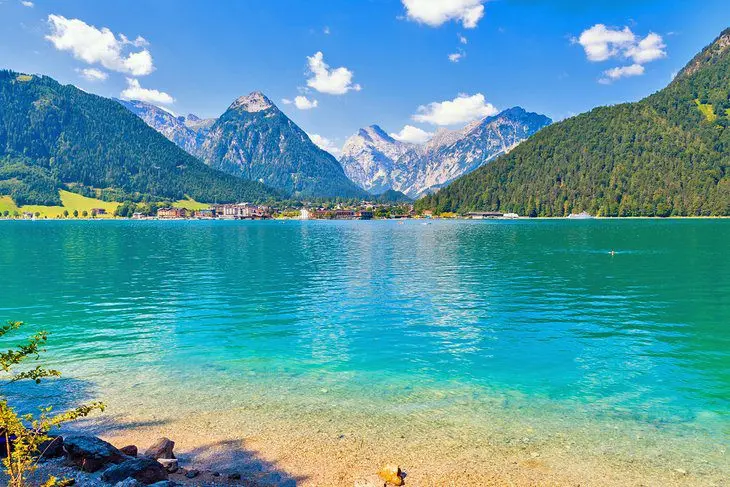
Often referred to as “Tyrol’s ocean” because of its massive size and “Fjord of the Alps” for its high water quality, Achensee is one of Austria’s best lakes for swimming. Be ready, though – like many other Alpine lakes, the temperature of the water stays low, even on the hotter days, reaching only around 20 degrees Celsius.
The quality of the water is excellent, with visibility up to 10 meters deep, which attracts not only swimmers but also scuba divers. Plus, thermal winds over the lake make it an ideal environment for windsurfing and kitesurfing.
During the summer, it’s also possible to rent boats or join a sailboat cruise. A number of modern steamer boats make their way around the lake, stopping at six major points along the way. There are even murder mystery dinner cruises available and Christkindl (Christmas market) boats during the holiday season.
The lake is surrounded by the Karwendel and Rofan mountains and offers many opportunities for hiking and biking. Nearby Bärenkopf mountain offers great trails up to the summit, from where you’ll get panoramic views over the lake.
2. Mondsee
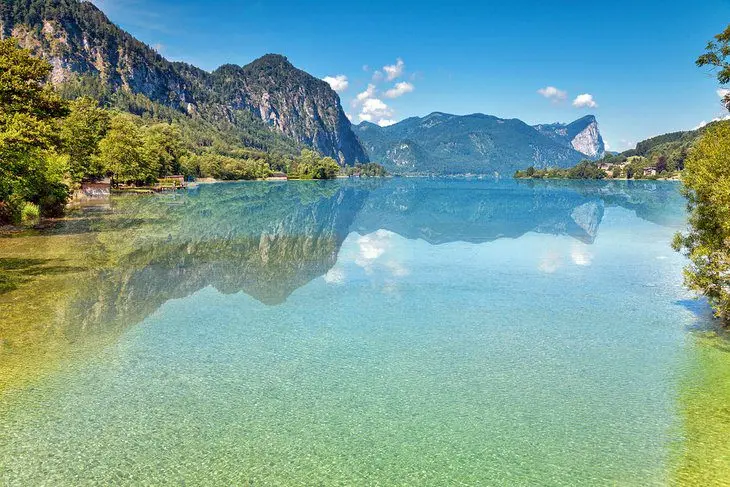
Mondsee is a lake near Salzburg that offers a wide variety of water-related things to do – including diving boards, giant slides, plenty of windsurfing, and the chance to canoe or rent your own electric boat to take on the waters.
At 11 kilometers long, Mondsee is a relatively large lake with calm blue waters. Luckily for swimmers, this is also one of the warmest lakes in the region, with water summer temperatures reaching a very balmy (by Austrian standards) 27 degrees Celsius.
The lake sits against the Drachenwand (Dragon Wall), an imposing limestone mountain partially covered in thick forest. Drachenwand attracts hikers and climbers, as well as BASE jumpers. Mondsee town on the shore is home to the little church where The Sound of Music’s Captain Von Trapp and Maria got married – a very popular attraction in a colorful town that seems out of a fairy-tale.
3. Lake Hallstatt
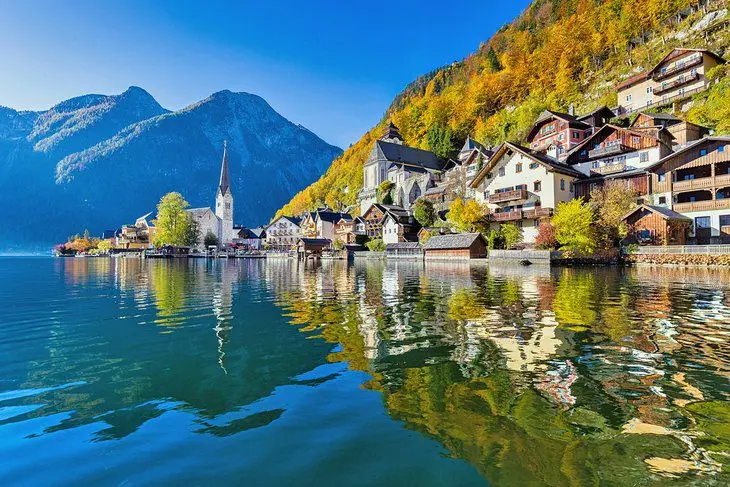
Hallstatt is one of Austria’s most visited lakes, in part because of the UNESCO World Heritage Site town on its shores, one of Austria’s oldest villages. The picture-perfect cobblestone streets, 16th-century wooden houses, and other attractions in Hallstatt just add to the charm of the lake, no matter what time of the year you’re visiting.
Hallstatt Lake’s shimmering and calm waters, with a maximum depth of 125 meters, are perfect for swimming, scuba diving, and boating. Kayaking and canoeing are popular here, but visitors can also take ferry rides in ancient wooden boats or join a discovery cruise.
For those wanting to take a dip in the cool waters, the 21-kilometer-long Lake Hallstatt offers plenty of shoreline options. There’s a family-friendly beach in Obertraun, a lakeside resort on Bad Goisern, and a bathing island and children’s playground just a few hundred meters from the center of town.
4. Plansee
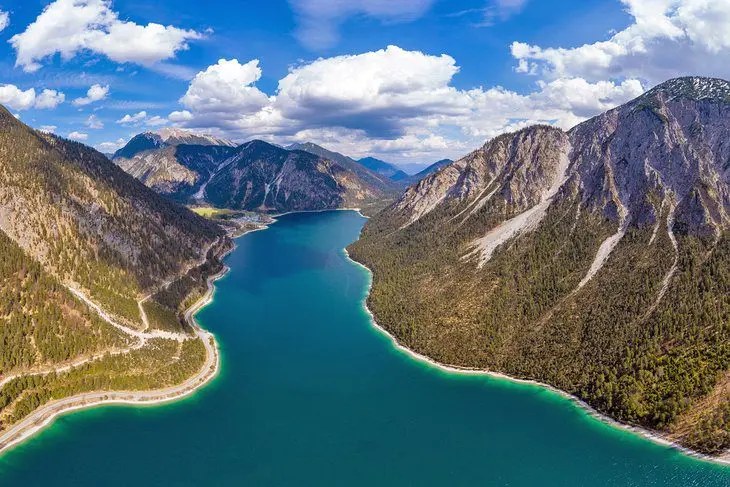
The second largest natural lake in Tyrol, near the border with Germany, Plansee covers 2.87 square kilometers with a depth of almost 80 meters. It’s often referred to as “the fjord of Austria” because of its majestic blue and greenish beauty, with water and mountains and forests melting into each other as far as the eye can see.
The waters here are so clear, you can see almost 15 meters down, making it a perfect destination for swimmers and divers.
Sailing and surfing are also popular here in summer, and many visitors spend time hiking or cycling the shores on trails that vary from the easy one-hour-long Ruine Ehrenberg loop from Reutte to the five-hour-long mountainous Thaneller trail that departs from Berwang.
During the winter months, many of the trails (including the Thaneller trail) are also accessible for snowshoers. The lake freezes over regularly, becoming a popular ice-skating rink.
5. Zellersee
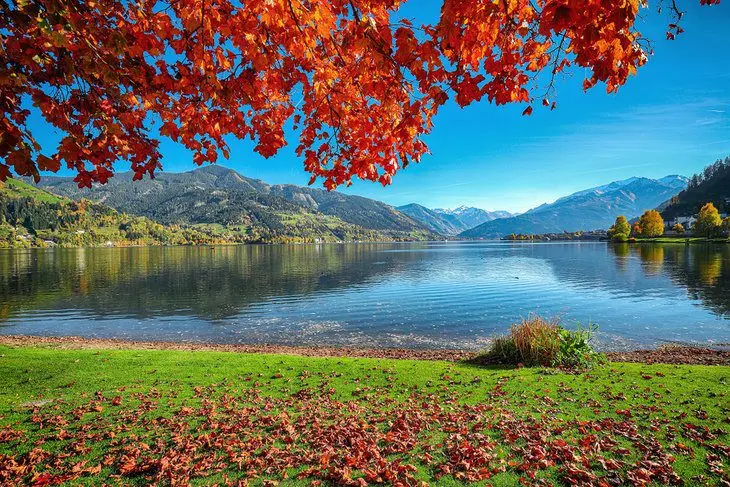
Despite its small size (only four kilometers long and 73 meters deep) and water temperatures staying around 18 degrees Celsius in summer, Zellersee is one of Austria’s best lakes for swimming. Formed about 10,000 years ago towards the end of the last Ice Age, the lake is still fed by numerous mountain streams, keeping the water clear all summer long.
No combustion engines can be run on the lake, but visitors can rent small electric boats to explore and relax on the water. Windsurfing, kitesurfing, and sailing are popular, too. The 19th-century promenade that runs along parts of the lake offers plenty of shade in the heat plus panoramic views over the water.
The lake freezes over in winter, allowing for ice-skating and curling against the backdrop of the magnificent snow-covered Alps. You can also don a pair of snowshoes to follow the footpaths around the lake, deep into the mountains and forests covered in powdery snow.
6. Attersee
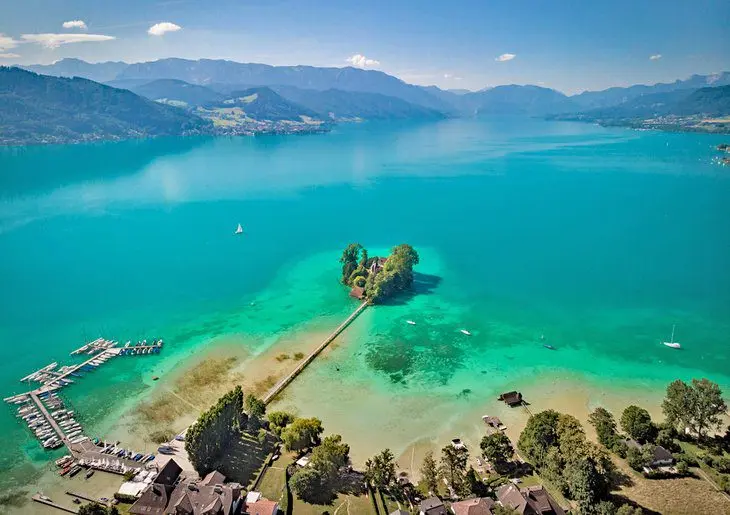
Just minutes outside Salzburg, Attersee is one of Austria’s largest lakes at 20 kilometers long. Its massive size means the lake doesn’t completely freeze during cold months, preventing winter sports from being played on the surface. From spring to fall, though, the area attracts lots of tourists, who come here for the excellent swimming in crystal blue waters.
Because the lake isn’t completely surrounded by mountains (aside from the Schafberg mountain and the Höllengebirge karst range towards the south) there are steady winds hitting the lake. This makes Attersee ideal for sailing and kitesurfing. The locals are especially fond of the Rosenwind (wind of roses), which flows through the gardens of a nearby castle before hitting the lake, bringing the smell of roses along.
The shores of Attersee are filled with Mediterranean-style villas; steep slopes perfect for some intense hiking; seaside resorts; and bathing areas with their own beach volleyball courts, sanitary facilities, and dog-friendly swimming.
7. Gosausee
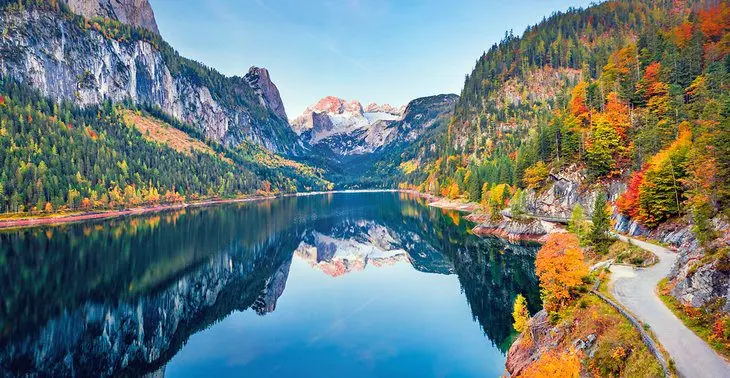
A set of three lakes sitting against jagged mountains and the Dachstein Glacier rising behind it, Gosausee makes for a perfect day trip from Salzburg. After all, there’s nothing more magical than swimming in the heat of summer surrounded by snowcapped mountains.
The waters of the lake are so clear that you can even see the glacier in the distance from underwater. Be ready for very cold swimming, though – the temperature of the water here rarely goes over 19 degrees Celsius and can get as low as 17 degrees, even in summer.
Boat rentals, stand up paddleboarding, and diving are all available at the lakes, and the surrounding thick-forested area is popular with hikers and climbers. There’s even a fixed-rope climbing route set up directly over the lake for stunning views over the Dachstein and the Gosau glacier.
Along the shorelines, you’ll find rustic huts offering local specialties and home-style cooking.
8. Grüner See
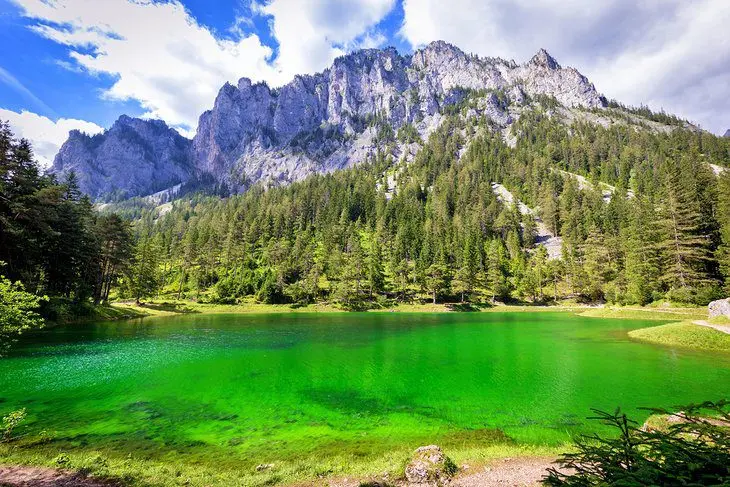
Grüner See (literally “Green Lake”) is a deep emerald-green lake surrounded by the Hochschwab Mountains and thick bluish forests. As snow melts and runs down the mountain and into the lake in spring, the lake gets deeper and more vibrant. This is when divers arrive to see underwater bridges, trees, and even a bench.
In fact, this is why the lake has its distinctive color: as the waters rise, they swallow the surrounding area, rising over 12 meters, even over the park’s resting benches. Since the waters are so clear, the grass and foliage underneath shine their bright green through.
In winter, as waters freeze and recede, the lake partially dries up, with the deepest areas reaching just one meter deep. Because of its small size and its fragile ecosystem, the lake is off-limits for sports activities. The action here is on the shores, as trails zigzag around for beautiful picture spots.
9. Traunsee
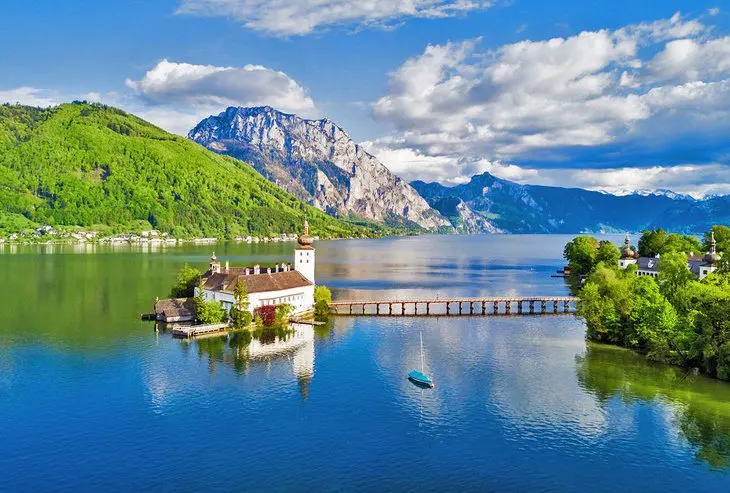
At 191 meters deep, Traunsee is Austria’s deepest lake and a favorite diving spot. The lake is surrounded by majestic mountains, including the Traunstein, with its almost vertical walls that are perfect for climbing.
The shorelines are also home to vast flowering meadows and picturesque market towns and quaint villages like Altmünster and Traunkirchen and Ebensee. Several ferries cross the lake to connect the different towns around the shore.
The lake is a very popular place to visit, famous for its ideal wind conditions perfect for sailing and windsurfing. In May and June, major boat races are hosted here, and sailing courses are offered for beginners who want to dip their toes into the water. If you’d rather sit back and relax, you can rent a small electric boat or take a cruise here as well.
The lake is home to Schloss Ort, a medieval fortress built on its own little island. Accessible by a long bridge and surrounded by small manicured gardens, the fortress is Traunsee’s favorite postcard image.
Come armed with a camera and an open mind when you visit. Legend says Traunsee is home to Lungy, Austria’s version of the Loch Ness monster.
10. Weissensee
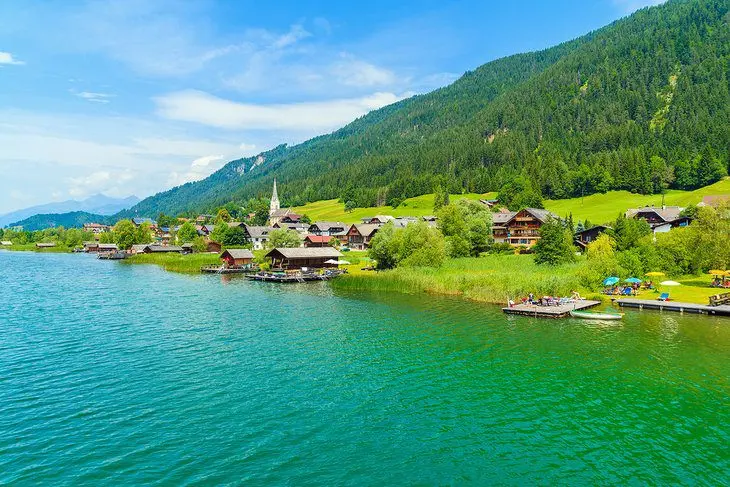
With over 2,000 hours of sunshine per year and crystal-clear, emerald waters, Weissensee is a favorite lake for swimming, diving, and cliff jumping. Even better, the water temperature here can reach 25 degrees Celsius in summer, much warmer than in other areas of Austria even in early fall.
The beauty of the lake is undeniable, surrounded by the stunning mountains of the Gailtal Alps and a beach area in the Stockenboi township. From here, you can rent equipment for all kinds of water sports, including windsurfing, canoeing, and water biking.
The lake’s turquoise-blue water is so clean, you can safely drink it. The lake also attracts plenty of wildlife, including geese and herons. The Weissensee Nature Park surrounding the lake offers over 200 kilometers of marked paths for hiking, biking, and Nordic walking. There’s even a chairlift to help you reach the higher trails if you’re up for a more intense day out, and the park offers 12 marked routes specifically for runners.
Weissensee is just as popular in winter as it is in summer. Despite its relatively large size (the lake is almost 12 kilometers long and just under one kilometer wide), it freezes over frequently, transforming into a spectacular ice rink. Cross-country skiing and some Alpine skiing are available around the lake.
11. Wolfgangsee
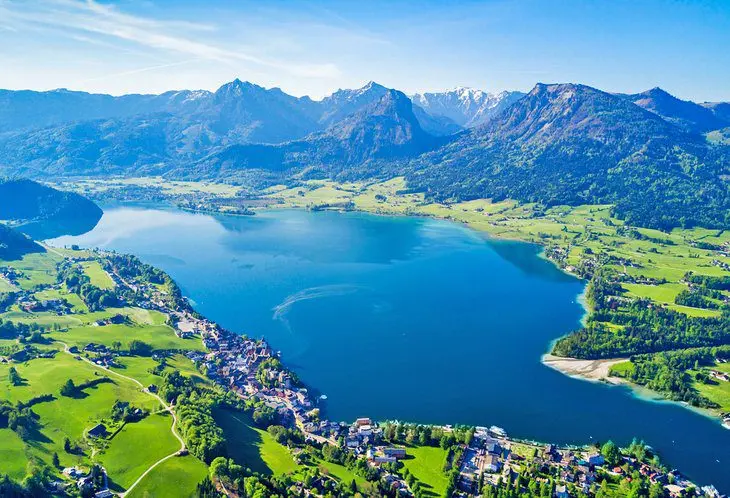
Wolfgangsee is one of Austria’s bluest lakes, a 13-kilometer-long body of water divided by the die Enge (the Narrow) peninsula about halfway. Here, the lake is just 200 meters wide, offering visitors a view of both shores and the breathtaking Salzkammergut mountain range.
You can reach the top of 1,783-meter-tall Schafberg mountain by catching a ride on the cogwheel Schafberg Railway – a slow ride up the mountainside with a total elevation gain of about 1,200 meters. The summit offers the best panoramic views over the lake and the mountains around, as well as access to a hotel and café.
A number of tucked-away resorts, such as St. Wolfgang and St. Gilgen, line up the coast, some of which have their own docks for those arriving by boat.
In addition to great kayaking and swimming, the lake is a prime destination for diving. The clear waters have a depth visibility of 10 meters and there is plenty to discover underwater, from sunken trees to WWII artifacts.
12. Faaker See

Faaker See’s main claim to fame is having the cleanest water of any lake in Austria. In fact, the clear turquoise waters are so clean, that they’re perfectly drinkable and offer stunning visibility. This makes the 2.2-square-kilometer lake a perfect destination for swimming, as the water can reach temperatures of up to 26 degrees Celsius from June to September.
The surroundings of the lake offer beautiful hiking and biking trails on nearby Mount Mittagskogel, plenty of hotels and restaurants on the shore (perfect to try local Carinthian cuisine), and a number of small beaches for soaking up the sun. Visitors can also find plenty of opportunities for yachting, canoeing, or playing volleyball on the sand.
Throughout the year, the lake becomes a hub for a number of events, including European Bike Week in September (the largest motorcycle meet in Europe), live concerts at the Finkenstein castle ruins, and beautiful advent markets in December. During winter, the lake often freezes over and becomes a natural ice-skating rink.










